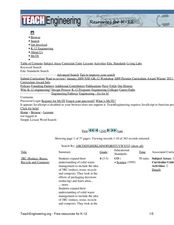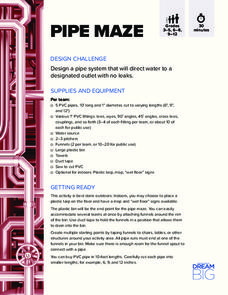Teach Engineering
You've Got to See it to Believe It!
Youngsters develop an understanding of how smog is produced, and how exhaust from automobiles is one of the major sources of smog. They explore the roles that engineers play in developing technologies that reduce smog, then work in teams...
Teach Engineering
Solar Power
Elementary schoolers discover how engineers use solar energy to heat buildings. They take a close look at some of the materials used: sand, salt, water, and shredded paper and evaluate the efficiency of each material. An incredible...
Teach Engineering
Capturing the Sun's Warmth
Passive solar heating is a technology that's been in use for thousands of years. Here, elementary schoolers are exposed to this type of heating, the materials that are used in passive solar heating, and they study how engineers design...
Institute of Electrical and Electronics Engineers
Exploring at the Nanoscale
Nano-nano! Nanotechnology can seem like it's from another planet! After learning about this tiny technology, collaborative groups experiment with how smaller particles affect chemical reactions. They do this by immersing a whole and a...
Curated OER
Science Week 2006
Students read these news reports: Science is hard and dull says kids, and PM behind Science Week campaign. They then discuss that the news stories show two sides of the public image of science in the UK. The teacher explains that...
Curated OER
Wright Again: 100 Years of Flight
Aspiring aeronautical engineers demonstrate different forces as they construct and test paper airplanes. This lesson plan links you to a website that models the most effective paper airplane design, an animation describing the forces...
Curated OER
Time for Design
Learners are introduced to the design process used in engineering. They compare and contrast this process with the steps followed in the scientific method. Students then participate in a brainstorming session that asks them to design a...
Curated OER
WWW, Part 2: The URL and Search Engines
Students examine the process for the creation of a home page and the use of HTML or Hypertext Markup Language. the lesson was originally written for librarians with little or no net experiences.
Texas State Energy Conservation Office
Investigation: Acceleration
Take a look at acceleration within the context of automotive technology. They vary the mass on a toy car and run it down a ramp, exploring Newton's second law of motion. Though this is a classic lab activity, you will appreciate the...
Curated OER
Cell Wall Recipe: A Lesson on Biofuels
Biotech engineers discover that changes in the DNA code for cell wall formation can help create crops better suited for biofuel production. They extract DNA from wheat germ. They decode paper strips with codes and relate the activity to...
Curated OER
Saving Sponge Bob Square Pants
Students apply the use of technology to real life scenarios. In this technology lesson, students discuss and identify a method to move sponge bob from one location to the next, without touching the floor. They share the same landmark and...
Curated OER
All About Computers
Students discover facts about computers. In this technology lesson, students find out how to locate information on the Internet. Students choose a topic to research and search several sites for information.
NASA
The X-1 Paper Glider Kit
After reading an interesting account of how the X-1 aircraft was designed, built, and utilized, young engineers try their hand at constructing a paper glider version of the airplane. They cut out the plane out of a nicely designed...
National Nanotechnology Infrastructure Network
Noodling Around: Powers of Ten
How many noodles long is your classroom? Find out when engineers of all ages explore measurement through the use of pool noodles. With the noodles pre-cut to certain metric lengths, the activities could be used to introduce the metric...
Curated OER
The Ups and Downs of Technology
Students create a visual timeline of skyscrapers built in the past 20 years. In this physical science lesson, students research important facts about the building. They discuss the challenges architects face when building skyscrapers.
Curated OER
How Can We Do Research on the Internet?
Students demonstrate how to use the Internet to research historical individuals. In this technology lesson, students use the "Internet Coach" CD-ROM to identify how to gather information on the Internet. Students choose an important...
Curated OER
Online Scavenger Hunt
Students participate in an online scavenger hunt to answer questions posed by the teacher. In this Internet search lesson, students are given specific questions and they have to use the Internet to locate the answers. There are links...
Curated OER
My Wet Robot
Young scholars design an underwater vehicle. In this engineering lesson, students will design an underwater robot that includes specific systems for it to function properly. Each group will present their prototype to the class.
PBS
Parachute Parade
Sail to the ground with a parachute activity! Kids construct parachutes out of household items and a toy figure, after brainstorming the best way to reduce drag. Once they test their parachutes, they can adjust their projects to optimize...
DiscoverE
Launch It
Launch pupil interest in rockets. Scholars build rockets out of straws and balloons to learn about Newton's Third Law of Motion. Their task is to hit a target five feet away. It's not as easy as it seems!
DiscoverE
Pipe Maze
Here's a lesson that is simply a-MAZE-ing! Introduce science scholars to pipeline systems through a hands-on project. Partnered pupils participate in the design, construct, and test a PVC pipeline maze. Reusable materials and clear...
DiscoverE
Puff Mobiles
You've probably heard of solar-powered cars, but what about wind-powered cars? Scholars build cars that can travel at least six feet. They can only use their breath to move the car—so, obviously, a sail might be a good feature for the...
DiscoverE
Shake It Up with Seismographs
Shake up your lessons on earthquakes. A simple seismograph lets scholars record "earthquakes" in the classroom. These earthquakes occur when classmates drop balls from different heights. Young scientists measure these with seismographs...
DiscoverE
Strong Paper Structure
Paper is a lot stronger than you think. Scholars create newspaper structures that can hold the weight of several books. For the purpose of this activity, the designs must be eight inches tall to be considered complete.

























